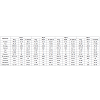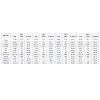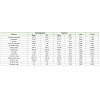Research Article
Impact of Food Based Strategies on Nutrient Intake of Rural Adolescent Girls
Kamalaja T1*, Prashanthi M2, Uma Maheshwari K3
1AICRP, Department of Foods and Nutrition, Faculty of Home Science, Hyderabad, Professor Jayashankar Telangana StateAgricultural University, Telangana, India
2AICRP, Department of Foods and Nutrition, Hyderabad, Professor Jayashankar Telangana State Agricultural University,Telangana, India
3PG & RC, Department of Foods and Nutrition, Faculty of Home Science, Hyderabad, Professor Jayashankar Telangana StateAgricultural University, Telangana, India
Corresponding author: Kamalaja Raghuram T, AICRP, Department of Foods and Nutrition, Faculty of Home Science,Hyderabad, Professor Jayashankar Telangana State Agricultural University, Telangana, India; E-mail: kiran2adi@yahoo.co.in
Citation: Kamalaja T, Prashanthi M, Uma Maheshwari K. Impact of Food Based Strategies on Nutrient Intake of Rural Adolescent Girls. Indian J Nutri.2016;3(2): 135.
Copyright © 2016 Kamalaja RT, et al. This is an open access article distributed under the Creative Commons Attribution License, which permits unrestricted use, distribution, and reproduction in any medium, provided the original work is properly cited.
Indian Journal of Nutrition | ISSN: 2395-2326 | Volume: 3, Issue: 2
Submission: 27/07/2016; Accepted: 19/08/2016; Published: 25/08/2016
Abstract
Nutrient intake during adolescence is very important as it is period of rapid development. The present study is an intervention study to know the impact of knowledge, awareness, attitude and practices on the nutrient intake of the adolescent girls. The pre intervention showed that adolescent mineral and vitamin intake was below the recommended dietary allowance. During the pre intervention the calorie intake was meeting only 70-75% of recommended dietaryallowance. Protein in taken was also found to be less than the required amount (on average only 85-90% adequacy for age group 13-16yrs). After intervention intake of food groups like rice, wheat, spinach, dark leafy vegetables, cabbage, eggplant, and mushrooms helped the experimental group in increased nutrient showing a significant difference from control group. The intake of calories increased to 85% adequacy level but proteins intake remained same. After intervention intake of vitamins like thiamine, riboflavin, B carotene, retinol increased. Minerals like calcium, iron and zinc intake of experimental group also increased due tofood based strategies like increased knowledge and awareness of food groups and their functions.
Introduction
Adolescence is a transitional growth period, with increased demands for energy and nutrients. This period is marked byrapid physical growth, reproductive maturation and cognitivetransformations. Good nutrition is needed to support the growthand developmental changes of adolescence. Total nutrient needsare higher during adolescence than any other time in the lifecycle.Nutrition and physical growth are integrally related; optimalnutrition is a requisite for achieving full growth potential. Duringthis phase of life, diet should provide not only sufficient caloriesbut also other nutrients such as protein, vitamins and mineralsbecause they boost the immune system, support normal physical growth and development. Nutrition is an input to the foundationfor health and development. Joshi et al. concluded that majority ofrural adolescent girls were under nourished [1]. There was significantassociation between socio-economic status (SES) and nutritionalstatus of adolescent girls. Nutritional status has profound effect onhealth and school performance of adolescent girls. Deshmukh et al.reported that majority (53.8%) of the adolescents were thin, only2.2% were overweight while 44.0% were normal [2]. Medhi et al.reported that 41.3% of the adolescent girls were thin [3]. Chaturvediet al. reported that the calorie intake was deficient by 36%, 34% and26%.Chaturvedi et al. reported that in the age group 10-12 years,13-15 years and 16-18 years, the protein deficit was 29%, 32% and 23% respectively [4]. Yadav and Singh reported that the magnitudeof stunting was 60% among the adolescents [5]. From these reviews it could be concluded that the nutrient intake of rural adolescent girls was not meeting the required dietary allowance and hence to tackle this, intervention was essential to change the attitude, knowledge, practice thereby increasing the nutrient intake of rural adolescent girls. Nutritional intervention required to improve intake of vitamins and minerals which are very important nutrient. Vitamins andminerals are important as they boost the immune system; supportnormal growth and development, and help cells and organs do theirjobs. Hence the present study was taken up to assess the impact offood based strategies on nutrient intake of adolescent girls.
Materials and Methods
The present study was conducted in rural Telangana district.A sample 300 adolescent girls in age group of 13-16yrs attendinggovernment schools were randomly selected. Out of the 300 sample70 girls who were anemic and under nourished were selected for thepresent study. From the sample of 70 adolescent girls in age groupfrom 13-16years with 35 girls in each experimental and control groupwere selected. Data of energy and nutrient intake was collected withthe 24-hour dietary recall and food record questionnaires. In the 24-hour dietary recall questionnaire, the participants were asked to recalland report all the nutrients, drinks, and dietary supplements theyhad in the past 24 hours. Data was collected before intervention andagain with gap of three months post intervention data was collected.Nutrition models, standardized measuring cups, spoons and othertools were used to estimate the correct amount of consumed food. Inthe food record questionnaire, the students were asked to report theirfood consumption on a specific day based on the number of spoons,cups and other common measuring tools. The food record was takencontinuously for period of 15 days where the participants recordedtheir daily intake of food. The advantage of the 24-hour dietary recallquestionnaire is that it is completed without any prior notice. Hence,the respondents do not change their food intake. However, because itrelies on the individual’s memory, the participants may not rememberall the foods they have. The data was analyzed using averages, SDs andt test to study the significant differences.
Results and Discussion
The nutrient intake of adolescent girls in three age groups before intervention was presented in the Table 1. The nutrient intake,RDA and percent adequacy of each nutrient in each age group waspresented in the table. Average intake of Calories and all nutrientsin all age groups was observed to be less than the recommendeddietary allowances except Fat intake in 16 years, Vitamin ‘C’ intakein 15 & 16 years, and Riboflavin intake in 14 years adolescents.The dietary fiber percent adequacy was found to be in range 80-90percent in age groups 13-16yrs adolescent girls. From the study itcould be concluded that the diet intake of adolescent girls was notsupplying recommended allowances of vitamins like B carotene,Retinol thiamine and riboflavin. The diet was also found to lackingminerals like iron, calcium and zinc. The study indicated thatthe percent adequacy of energy was also less when compared toRDA.
The post intervention nutrient intake of experimental group inage 13-16yrs was presented in the above table. Average intake ofCalories and all nutrients in all age groups was observed to be morethan pre-intervention level except Fat intake in 16 years, Proteinintake in 13-16years, Vitamin ‘C’ intake in 15 years, Riboflavin intakein 13-14 years and dietary fiber intake across 13-16 years adolescents.In addition, in 15 years adolescents’, average intake of β-carotene andRetinol was less as compared to the pre-intervention levels [Table 2].
The impact of intervention was studied comparing the meannutrient intake of experimental and control group. Average intakeof the Carbohydrates, Fats, Total minerals, Calories, Calcium, Iron,Zinc, β-carotene, Thiamine and Riboflavin was significantly higher inpost-intervention phase as compared to the pre-intervention phase.Average intake of the Protein and Vitamin ‘C’ was higher in postintervention phase as compared to the pre-intervention phase butthis difference was not statistically significant. Average intake of theRetinol was almost similar in both pre phase and post-interventionphase. Though average intake of the dietary fiber was higher in preintervention phase as compared to the post-intervention phase butthis difference was not statistically significant. In a similar study Seema choudhary studied dietary pattern and nutrition related knowledge of rural adolescent girls and found that more than two third subjects hadin adequate intake of calorie, protein and fat and high level of vitamina deficiency prevailed in majority (>90%) of subjects [6]. Average intakes of macro and micronutrients (except vitamin a) were >70% of the RDA and average intakes of both macro and micronutrient(except vitamin a) were least in 13-16 years age group. The studyalso reported that access of nutrition related knowledge was poor foradolescent girls. Their nutrition related knowledge was not up to themark and majority of them were not aware about their nutritionalneeds. Ignorance about micronutrients and protective foods prevailedin adolescent girl. In another study Sneha Prakash, impartednutrition education through audio-visual aids for three months incollege settings. Before and after imparting nutrition education,the changes in eating patterns were evaluated by questionnairemethod. The study showed that dietary intakes for energy and fatswere more than adequacy, while protein and iron consumption wasmore according to comparison with RDA. A significant improvementin their nutritional knowledge was observed after giving NutritionalEducation Programme [Table 3].
Conclusion
Average intake of Calories and all nutrients in all age groups wasobserved to be less than the recommended dietary allowances exceptvery few nutrients in certain age groups. After intervening with‘Food Based Strategies’ which included advocacy for increased intakeof Green Leafy Vegetables especially dark green leafy vegetable the average intake of Calories and almost all nutrients in almost all agegroups was observed to be more than pre-intervention level. Thus theauthors conclude that ‘Food Based Strategies’ had a positive impacton the average nutrient intake of rural adolescents.
References
- Joshi SM, Likhar S, Agarwal SS, Mishra MK, Shukla U (2014) A Study of Nutritional Status of Adolescent Girls in Rural Area of Bhopal District. Natl J Community Med 5: 191-194.
- Deshmukh PR, Gupta SS, Bharambe MS, Dongre AR, Maliye C, et al. (2006) Nutritional status of adolescents in rural Wardha. Indian J Pediatr 73: 139-141.
- Medhi GK, Hazarika NC, Mahanta J (2007) Nutritional status of adolescents among tea garden workers. Indian J Pediatr 74: 343-347.
- Chaturvedi S, Kapil U, Gnanasekaran N, Sachdev HP, Pandey RM, et al. (1996) Nutrient intake amongst adolescent girls belonging to poor socioeconomic group of rural area of Rajasthan. Indian Pediatr 33: 197-201.
- Yadav RJ, Singh P (1999) Nutritional status and dietary intake in tribal children of Bihar. Indian Pediatr 36: 37-42.
- Choudhary S, Mishra CP, Shukla KP (2010) Dietary pattern and nutrition related knowledge of rural adolescent girls. Indian J Prev Soc Med 41 No.3 & 4.



